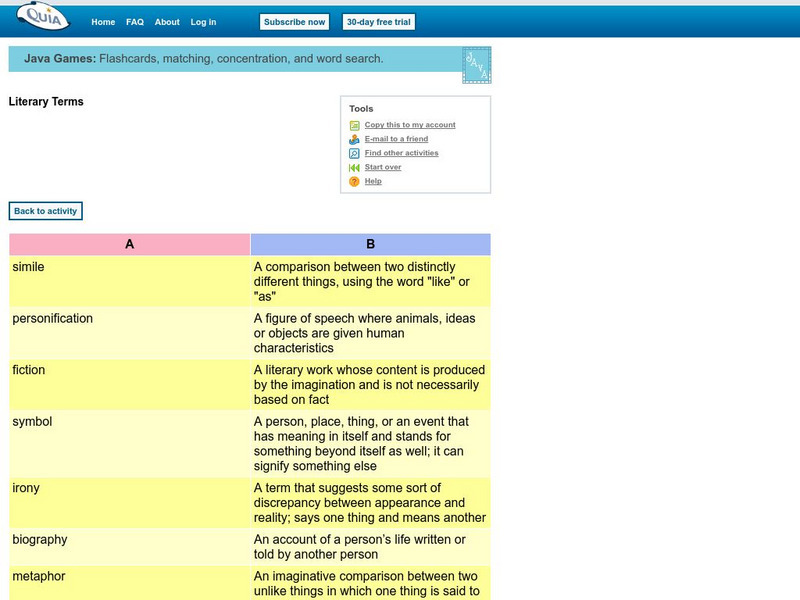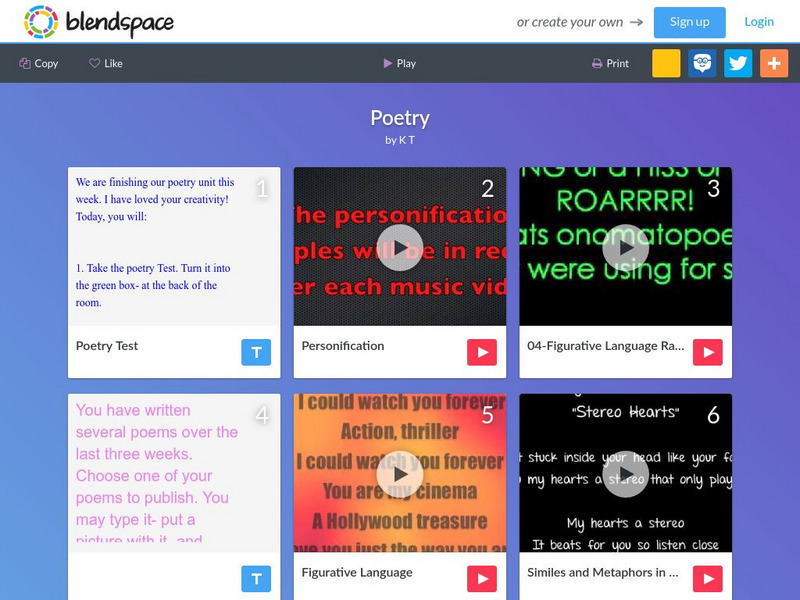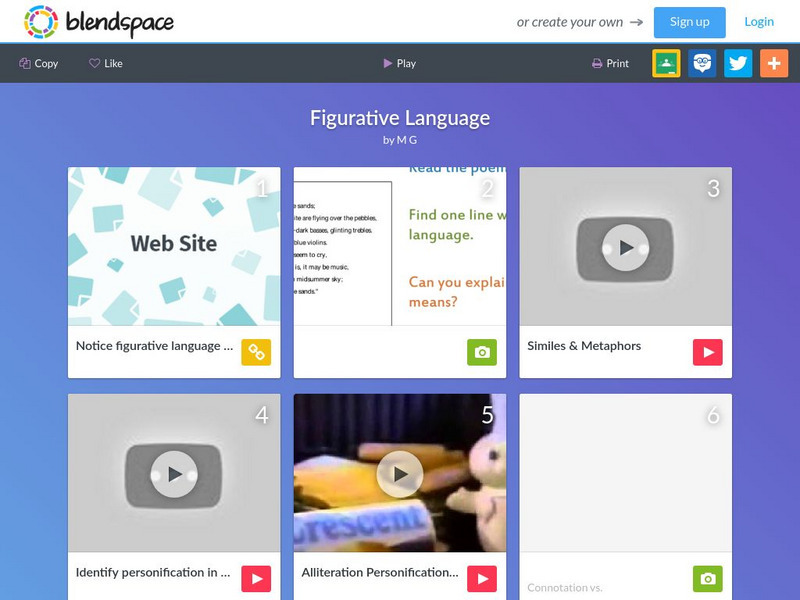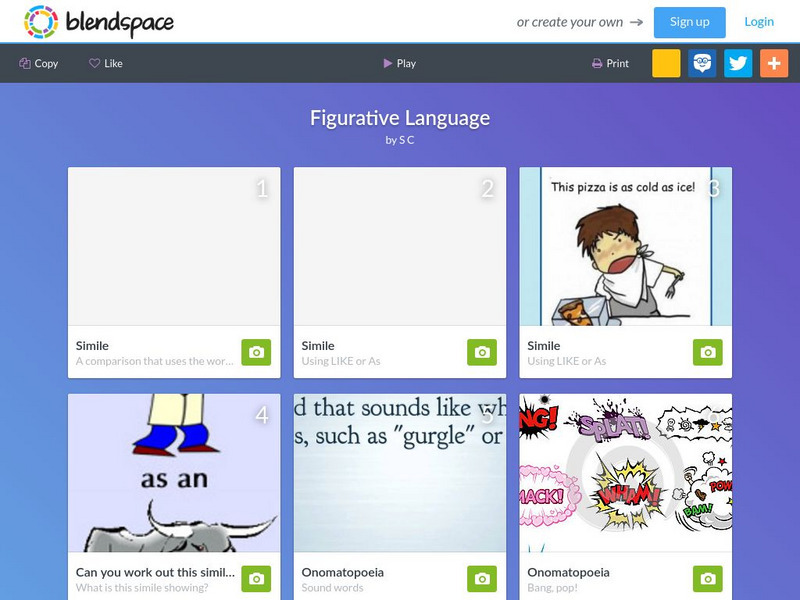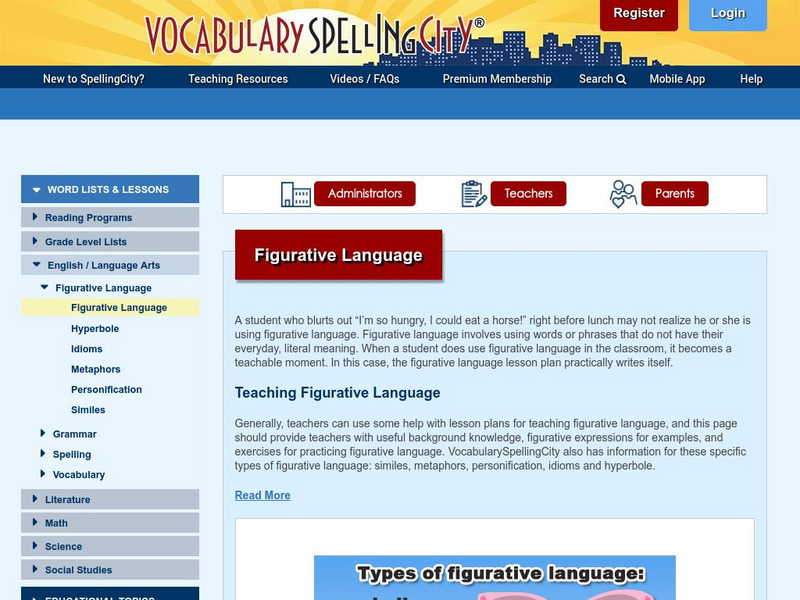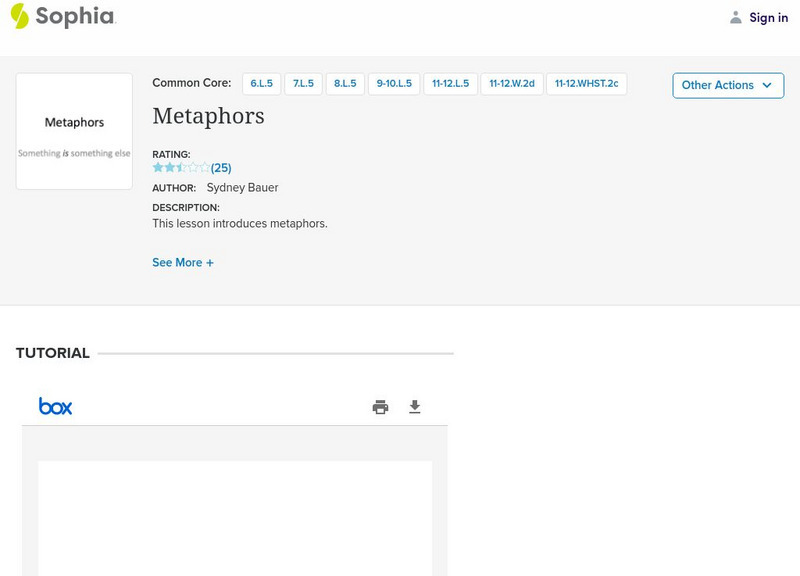Quia
Quia: List of Literary Terms
A list of 28 literary terms with brief, clear definitions. "Nonfiction," is the last term in the list.
TES Global
Blendspace: Interpreting Literature Terms
A fourteen-part learning module on literary terms including links to text, videos, word lists and images on literary terms such as plot, setting, character, point of view, style, theme, and more.
TES Global
Blendspace: La Figurative Language: Alliteration
A six-part learning module with images, charts, and videos filled with explanations and examples of alliteration.
TES Global
Blendspace: Reading Assessment Terms
A learning module that includes ten links to videos, websites, and assessments that review literary terms such as poetic devices, figurative language, literary elements, literary terms, and more.
TES Global
Blendspace: Poetry
A six-part learning module with links to texts and videos on figurative language in poetry.
TES Global
Blendspace: Gallagher Figurative Language
A learning module with thirty-one links to images, texts, websites, and videos to on figurative language including simile, metaphor, personification, idiom, alliteration, hyperbole, and onomatopoeia.
TES Global
Blendspace: Figurative Language
A fifteen-part learning module with links to images, texts, and websites to use while learning about figurative language including simile, metaphor, idioms, and more.
TES Global
Blendspace: Figurative Language
A thirteen-part learning module with links to websites, images, videos, and texts to use while learning about figurative language.
TES Global
Blendspace: Figurative Language
A ten-part learning module with links to videos, websites, texts, and a quiz on figurative language simile, metaphor, idiom, cliche, symbolism, and more.
TES Global
Blendspace: Figurative Language 6th Grade
A seven-part learning module with links to websites, videos, and a chart about figurative language including simile, metaphor, alliteration, hyperbole, anthropomorphism, and idiom.
TES Global
Blendspace: Figurative Language
A nine-part learning module with links to images and a video about figurative language including simile, onomatopoeia, and metaphor.
TES Global
Blendspace: Learning Figurative Language Rap
A learning module with twenty-four links to websites, images, texts, and videos to use while learning about figurative language.
Other
Prezi: Tone, Diction, and Analysis of Word Choice
Slideshow explores the connection between word choice and the author's tone.
ClassFlow
Class Flow: Proverbs
[Free Registration/Login Required] In this flipchart the student identifies the characteristics of various genres and produces evidence of reading that responds to and analyzes the effects of sound, figurative language, and graphics in...
Vocabulary Spelling City
Spelling City: Figurative Language
This website focuses on figurative language: hyperbole, simile, metaphor, personification, and idioms. It provides lists of examples for each based on three educational levels: elementary, middle school, and high school.
ClassFlow
Class Flow: Figurative Language
[Free Registration/Login Required] This resource explores figurative language including similes, metaphors, and personification. There are many activities used to support the exploration of each type of figurative language.
ClassFlow
Class Flow: Figurative Language and Persuasive Writing
[Free Registration/Login Required] This flipchart reviews figurative language and persuasive writing. It also includes an Activote session.
ClassFlow
Class Flow: Figurative Language and Sound Devices
[Free Registration/Login Required] This flipchart is intended for students in grades 4 and 5 who have been introduced to the terms simile, metaphor, hyperbole, alliteration, and onomatopoeia. The activities in the flipchart give...
ClassFlow
Class Flow: Idioms
[Free Registration/Login Required] This lesson is an introduction to idioms. It is intended to meet Nevada 8th grade standards in relation to figurative language and idioms.
E Reading Worksheets
E Reading Worksheets: English Worksheets and Tests
Downloadable worksheets and tests focusing on reading, figurative language, genre, language arts, point of view, and text structure for middle grades.
Sophia Learning
Sophia: Metaphors
This slideshow lesson focuses on the literary device metaphor. It defines the term, explains its purpose, and provides examples. W.11-12.2d Lang/Fig/Voc
Ted Nellen
Cyber English (By Ted Nellen): Denotation
Brief definition of the term denotation provided. Several examples given and a link to the term connotation provided.
Other
Common Core Standards Bellringers: Grade 8: English Language Arts [Pdf]
See pages 15, 31, and 47 of this 227-page document for activities where students must order sets of words from most negative to most positive connotation.
University of Cambridge
University of Cambridge: The Virtual Classroom Glossary of Literary Terms
Glossary of Literary Terms provided by the University of Cambridge Faculty of English. Seventy terms are included, and they are given between one sentence and a paragraph of explanation each.


